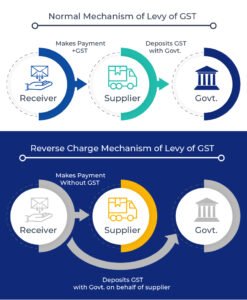Groups in Tally Prime
1. What are Groups in Tally? In Tally Prime, Groups are used to classify ledgers into different categories so that transactions can be properly recorded and reports (like Balance Sheet, Profit & Loss A/c, Trial Balance) can be automatically prepared. 👉 Think of groups as folders, and ledgers as files inside those folders.Each ledger must

Accounting: Supply Chain Management (SCM)
Supply Chain Management refers to the coordination and management of all activities involved in sourcing, production, and delivery of goods and services. It includes planning, procurement, manufacturing, logistics, and customer service, ensuring that products reach end-users efficiently and cost-effectively. Key Components of SCM Planning: Determining demand, creating production schedules, and forecasting inventory needs. Sourcing: Selecting

Accounting: E-way Bill
The E-Way Bill (Electronic Way Bill) system is a critical component of India’s Goods and Services Tax (GST) regime. It facilitates seamless movement of goods across states and within states while ensuring transparency in transportation and taxation. Introduced on April 1, 2018, the E-Way Bill has become an essential compliance tool for businesses. This post

Accounting: Composition Scheme Under GST
The Composition Scheme under GST (Goods and Services Tax) in India is a simplified taxation system designed to reduce the compliance burden for small businesses. It allows eligible taxpayers to pay GST at a lower rate with minimal paperwork, enabling them to focus more on their core business activities. In this post, we’ll explore the

Accounting: E-invoicing
The introduction of E-Invoicing in India under the GST regime is a revolutionary step towards digitizing the invoicing process for businesses. E-Invoicing ensures seamless integration with the GST system, reduces manual errors, and promotes transparency. This guide explores the concept, applicability, benefits, generation process, and practical examples of E-Invoicing. What is E-Invoicing? E-Invoicing, or electronic

Accounting: Reverse Charge Mechanism
Under the Goods and Services Tax (GST) in India, the Reverse Charge Mechanism (RCM) shifts the responsibility of paying GST from the supplier to the recipient of goods or services. This provision ensures tax compliance in cases where suppliers might not be registered or when the government deems it necessary. In this post, we’ll explore

Accounting: GST Returns
Filing GST Returns is an essential compliance requirement for businesses operating under the Goods and Services Tax (GST) system in India. GST Returns are documents containing details of income, sales, purchases, and taxes paid during a specific period. These returns help the government track the flow of goods and services and ensure accurate tax collection.

Accounting: Goods and Services Tax
The Goods and Services Tax (GST) is a landmark reform in India’s taxation system, aimed at simplifying the indirect tax structure by consolidating multiple taxes into a single framework. Introduced on July 1, 2017, GST replaced various state and central taxes, transforming the way businesses operate in India. This post provides an in-depth understanding of

Accounting: Heads of Income According to Income Tax
In India, income tax is calculated based on the type of income earned. The Income Tax Act, 1961, categorizes income into five distinct heads. Understanding these categories is crucial for accurate tax filing and maximizing exemptions and deductions. This guide explores the five types of incomes recognized under Indian income tax laws, along with detailed

Accounting: Income Tax
Income Tax is a vital aspect of financial management in India. It’s a direct tax levied on the income of individuals, businesses, and other entities. Understanding income tax is essential for compliance and planning your finances effectively. This detailed guide explores the fundamentals, types, slabs, exemptions, and practical examples related to income tax in India.

Accounting: Invoice
When a business provides a service or a product to the customer, an invoice or voucher is raised for the amount due. It is essential to understand the different types of invoices that can be raised for different purposes. The types of invoices used generally differ by industry, type of service/product, and mode of payment.

Accounting: Cash Flow Statement vs. Funds Flow Statement
In financial accounting, understanding the movement of funds is essential for analyzing a company’s financial health. Two important tools for this purpose are the Cash Flow Statement and the Funds Flow Statement. While they may appear similar, they serve different purposes and provide unique insights. Let’s explore these statements in detail with examples. What is

Accounting: Final Accounts and Adjustment Entries
Final accounts are a crucial aspect of financial accounting that summarize a business’s financial position and performance for a specific period. To ensure accuracy, adjustment entries (provisional entries) are made before finalizing the accounts. These entries account for transactions or events that are not yet recorded in the books but are relevant to the period.

Accounting: Balance Sheet
The Balance Sheet is a financial statement that lists a company’s assets, liabilities, and equity. The fundamental equation that governs the Balance Sheet is:Assets = Liabilities + Equity This equation ensures that the company’s resources (assets) are financed by either borrowing (liabilities) or owners’ investment (equity). Components of a Balance Sheet AssetsAssets are resources owned

Accounting: Trial Balance
The Trial Balance is a foundational tool in financial accounting. It serves as a preliminary check on the accuracy of an organization’s bookkeeping and forms the basis for preparing financial statements. In this post, we’ll explore what a trial balance is, its purpose, structure, and process of preparation, along with detailed examples. What is a

Accounting: Profit and Loss Account
The Profit and Loss Account provides a detailed account of the business’s financial performance over a given period, such as a month, quarter, or year. It calculates the net profit or loss by deducting all expenses from revenues. The formula for Net Profit/Loss:Net Profit/Loss = Total Revenue – Total Expenses Purpose of the Profit and

Accounting: Payment Methods in the Banking System
In today’s digital world, banking systems offer a variety of payment methods to facilitate smooth and secure financial transactions. These methods cater to individual needs, providing speed, convenience, and security for both personal and business purposes. This post explores the primary payment methods used in banking, their features, advantages, and examples to help you understand

Accounting: Types of Loans Offered by Banks
Banks play a critical role in providing financial assistance to individuals, businesses, and governments by offering various types of loans tailored to specific needs. Understanding the types of loans available is crucial for making informed financial decisions. Here’s an in-depth look at the different types of loans offered by banks, along with examples. 1. Personal

Accounting: Intellectual Property
Intellectual Property (IP) refers to intangible assets that arise from human creativity, such as inventions, artistic works, designs, symbols, names, and trade secrets. In financial accounting, intellectual property is classified as an intangible asset and is accounted for in the books of an organization. This post explores the concept of intellectual property, its types, its

Accounting: Cash Withdrawal slip and Cash Deposit Slip
Cash Withdrawal Slip and Cash Deposit Slip: A Comprehensive Guide In banking and financial accounting, cash withdrawal slips and cash deposit slips are essential documents used to facilitate transactions. These slips ensure accuracy, accountability, and proper record-keeping when handling cash. This post will explain what these slips are, their components, and how to fill them

Accounting: Bank
A bank is a financial institution that acts as a mediator between depositors and borrowers. It accepts deposits from individuals and businesses, safeguards the money, and provides loans to those in need. Banks play a vital role in the economy by facilitating financial transactions, promoting savings, and providing credit for economic development. In simple terms,

Accounting: Cheque
A cheque is a widely used payment method in both personal and business transactions. It serves as a written order directing a bank to pay a specific amount from the account of the issuer (drawer) to the person or entity named on the cheque (payee). Understanding how a cheque works and the various components written

Accounting: Bank Reconciliation Statement
A Bank Reconciliation Statement (BRS) is an important tool in financial accounting used to reconcile the differences between a company’s cash book and the bank statement. The purpose of the bank reconciliation process is to ensure that the cash balance shown in the company’s accounting records matches the amount shown in the bank’s records. Regular

Accounting; Types of Accounting
Accounting is a broad field with various branches, each serving a unique purpose to help businesses make informed decisions and maintain accurate financial records. Among the various types of accounting, Financial Accounting, Cost Accounting, Management Accounting, and Human Resource (HR) Accounting are the most widely recognized. These branches help businesses track their performance, manage costs,

Accounting: Types of Bank Accounts
Bank accounts play a crucial role in managing business finances and keeping track of transactions. Understanding the different Types of Bank Accounts is essential for effective financial accounting, as each type serves specific purposes and requires distinct accounting treatments. In this post, we will explore the main types of bank accounts used in businesses and

Accounting: Types of Firms
Financial accounting plays a vital role in analyzing and presenting the financial position of different types of firms. Understanding these types is essential for accounting students, professionals, and business owners. 1. Sole Proprietorship A sole proprietorship is owned and operated by a single individual. It’s the simplest form of business structure, where the owner is

Accounting: Types of Organizations
In financial accounting, the type of organization significantly influences the way financial transactions are recorded, reported, and analyzed. Businesses are broadly classified into three primary types: Service Organizations, Trading Organizations, and Manufacturing Organizations. Each type has its own set of accounting requirements, which must be understood to ensure accurate financial reporting. Let’s dive into the

Accounting: Difference between Book-keeping and Financial Accounting.
Understanding the distinction between bookkeeping and financial accounting is essential for students and professionals in the field of finance and business management. While both are integral to the financial ecosystem, they serve different purposes and involve distinct processes. Let’s explore the key differences: 1. Definition Bookkeeping:Bookkeeping is the process of recording and organizing all financial

Accounting: Financial Accounting Terminology-4
Unlocking Financial Accounting: Essential Terminology for Students Financial accounting is the language of business. To succeed, students need to familiarize themselves with its key terms and concepts. Here’s another fresh set of terms to enrich your understanding and boost your confidence in accounting: 1. Trial Balance Adjustment Entries These are entries made at the end

Vocabulary: Descriptive Words to Describe the Environment
The environment has countless facets, each evoking a unique feeling or imagery. From lush green forests to eerie, barren landscapes, having the right vocabulary can make your descriptions come alive. Below is a curated list of descriptive words to articulate different types of environments. Describing Natural Environments Landscapes Mountainous: hilly, rugged, elevated, majestic, towering. Forested:

Vocabulary: Descriptive Words to Describe Taste
The ability to describe taste is essential for talking about food, drinks, and culinary experiences. Here’s a comprehensive list of descriptive words categorized by the type of taste they represent. Use these words to expand your vocabulary and make your conversations more vivid and engaging! Basic Tastes Sweet – Having a sugary flavor. Examples: Candy,

Vocabulary: Descriptive Words to Describe Sound
Sound adds richness to our experiences and emotions, and describing it accurately can make your communication more vivid and impactful. Below is a comprehensive list of descriptive words for sounds, organized into categories for easier learning. General Sound Descriptions Loud – A high volume or strong intensity. Examples: thunder, sirens. Words: deafening, booming, blaring, roaring,

Vocabulary: Descriptive Words to Describe Touch
The sense of touch allows us to perceive the texture, temperature, and quality of objects. Here’s a detailed list of descriptive words you can use to describe tactile experiences, organized by categories for better understanding. Texture Smooth – Having an even and soft surface. Examples: silk, polished wood. Words: silky, glossy, sleek, velvety, satiny. Rough

Vocabulary: Descriptive Words to Describe Smell
The sense of smell can evoke memories, emotions, and vivid imagery. Here is a comprehensive list of descriptive words to help you articulate different types of scents in English. Pleasant Smells Floral – Associated with flowers. Examples: roses, jasmine. Words: fragrant, perfumed, aromatic, sweet-smelling, flowery. Fresh – Clean and revitalizing. Examples: morning dew, freshly baked

Vocabulary: Descriptive Words to Describe Quality
The quality of an object, person, or experience refers to its characteristics or traits. Descriptive words can help you effectively convey the level, condition, or value of something. Here’s a detailed vocabulary list to describe quality in various contexts. Positive Qualities High Quality – Superior in standard. Words: excellent, premium, first-rate, superior, top-notch, flawless, immaculate,
